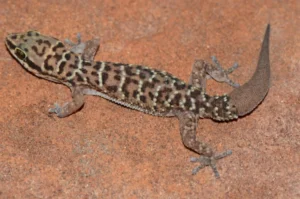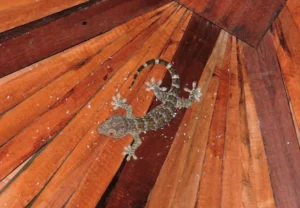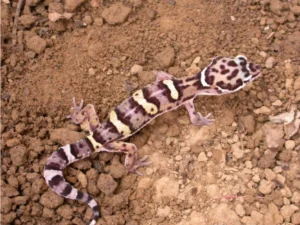It’s late evening, and you’re watching your gecko move around its tank. The soft light catches its skin, and you notice something unusual. Its tail starts wiggling.
Not the whole body, just the tail, twitching side to side in slow, careful motions. At first, it looks random. Then you start to wonder, why does it do that? Do geckos actually wag their tails on purpose?
Yes, geckos do wag their tails and it’s not random. They use tail movements to communicate, defend themselves, hunt, and even show how they feel. The tail works like a built-in language tool. The way they move it, slow, fast, twitchy, or still, can mean very different things depending on the situation.
Once you know what each movement means, watching your gecko becomes a lot more interesting. Their tails tell little stories if you pay attention.
Different Ways Geckos Move Their Tails
If you spend time watching your gecko, you’ll notice patterns. A slow, cautious wag is very different from a quick, jerky shake. Each style of tail movement has its own meaning.
1. Slow Tail Wagging
This is one of the most common tail movements. You’ll see it when your gecko spots something interesting or suspicious. It lifts its tail slightly and moves it slowly back and forth, almost like a cat getting ready to pounce.

This slow wag usually means your gecko is alert or cautious. It might be watching prey, studying your hand, or noticing another gecko nearby. It’s like it is saying, “I see something, but I’m not sure about it yet.”
You’ll see this a lot with leopard geckos when they focus on crickets or roaches. Their body stays still, but that tail quietly gives them away.
2. Fast Tail Wagging or Shaking
When the tail starts moving quickly, those sharp, side-to-side twitches, it’s sending a very different message.
Males often do this when they see a female. They shake their tails rapidly before approaching. It’s a mating signal that basically says, “I’m here, and I’m interested.”
But fast wagging can also mean the opposite. If your gecko feels threatened or unsure, it may twitch its tail quickly as a warning.
Context matters. If your gecko is alone and suddenly starts shaking its tail while looking at you, it might be saying, “Back off, I don’t trust this yet.” Over time, you’ll learn to tell the difference between excitement and warning.
3. Tail Arching or Curling Up
When a gecko arches its tail over its back, that’s usually defensive. It’s like saying, “Don’t mess with me.”
This helps them look bigger and more threatening to predators. It also sets them up for their ultimate defense move, tail dropping.

If a gecko feels trapped or attacked, it might arch its tail, wag it, and then drop it to distract the predator. The tail keeps wriggling for a while, giving the gecko time to get away.
It’s a wild survival trick, but it works. Even though losing the tail is stressful, it saves their life.
4. Gentle Tail Waving in Baby Geckos
Baby geckos move their tails a little differently. Their wagging is softer and more uncertain.
You might see them wave their tails slowly while exploring or when they notice movement around them. This helps them sense vibrations and air movement.
It’s like a little radar for staying safe. It’s cute to watch, but it’s also instinctive. They’re learning what’s safe and what’s not.
Communication Through Tail Wagging
Tail wagging isn’t random. Since geckos don’t make much noise, their tails do a lot of the talking.
For example:
-
Males wag their tails to show dominance or attract females.
-
Females may wag slowly to show they are annoyed or want space.
-
Both might wag defensively if they sense danger or see a rival.
It’s like geckos’ version of body language. Each movement helps avoid fights or misunderstandings.
If geckos are accidentally housed together, you’ll see this even more. One might wag its tail to warn the other, “This is my space. Don’t come closer.”
Tail Wagging Before the Hunt
If you’ve watched a gecko right before it strikes at prey, that slow tail wiggle is a clue.
Leopard geckos are known for this. They focus on the insect, crouch slightly, and their tail starts to sway slowly.

Scientists think this helps with balance and focus. The tiny tail movements might help stabilize their body or even make insects move in a way that makes them easier to catch.
It’s instinct and strategy working together, and once you notice it, you’ll see it every time your gecko hunts.
Tail Wagging and Emotions
Geckos don’t have emotions like humans, but their behavior can show how they feel.
Here’s a simple guide:
-
Relaxed, slow tail movements = calm, curious, or content.
-
Fast, jerky wagging = alert, excited, or defensive.
-
Tail held high or curled = ready to protect itself.
If your gecko wags its tail while exploring or before eating, that’s normal. If it does fast flicks when you approach, it might be scared or stressed.
Give it space, move slowly, and be consistent. That nervous wagging will fade as your gecko starts to trust you.
Tail Wagging During Mating Season
During mating season, tail movements get more obvious.
Male geckos often wag their tails quickly when they see a female. Some even vibrate their bodies or make soft chirping sounds.
It’s their courtship signal. The female might respond by moving her tail slowly or staying still. It’s their way of showing interest and coordinating mating without fighting.
Watching this is like seeing a delicate dance between two small, instinct-driven animals.
When Tail Wagging Means Trouble
Tail wagging can also be a warning sign. If your gecko wags its tail rapidly every time you approach, or keeps doing it for no reason, it might be stressed.
Stress can come from:
-
New environments or sudden changes.
-
Loud noises or other pets nearby.
-
Too much handling too soon.
-
Tank mates (geckos are usually solitary).
If you notice defensive wagging a lot, check the tank. Make sure there are enough hides, proper temperatures, and few stress factors.
Once your gecko feels safe, the tail twitching will calm down.
The Tail: More Than Just Decoration
A gecko’s tail is full of muscles and fat. It’s not just for balance or communication.
When food is scarce, geckos can survive by using the fat stored in their tails. That’s why a healthy gecko has a plump, rounded tail.
Tail wagging shows how useful it is. It helps with hunting, defense, communication, and survival. Losing it is stressful, but geckos can grow a new one over time. The new tail often looks a bit different, but it works.
Conclusion
So, do geckos wag their tails? Yes they do.
They wag to communicate, to hunt, to flirt, or to defend themselves. A slow wag usually means curiosity or focus, while a quick shake could mean excitement or fear.
Once you start noticing the patterns, you’ll see your gecko has been “talking” to you all along. Their tails aren’t just decoration, they’re a language made of subtle movements and instinct.
Even a tiny wag can tell you exactly what your gecko is thinking.
Hi, my name is Ezra Mushala, i have been interested animals all my life. I am the main author and editor here at snakeinformer.com.

